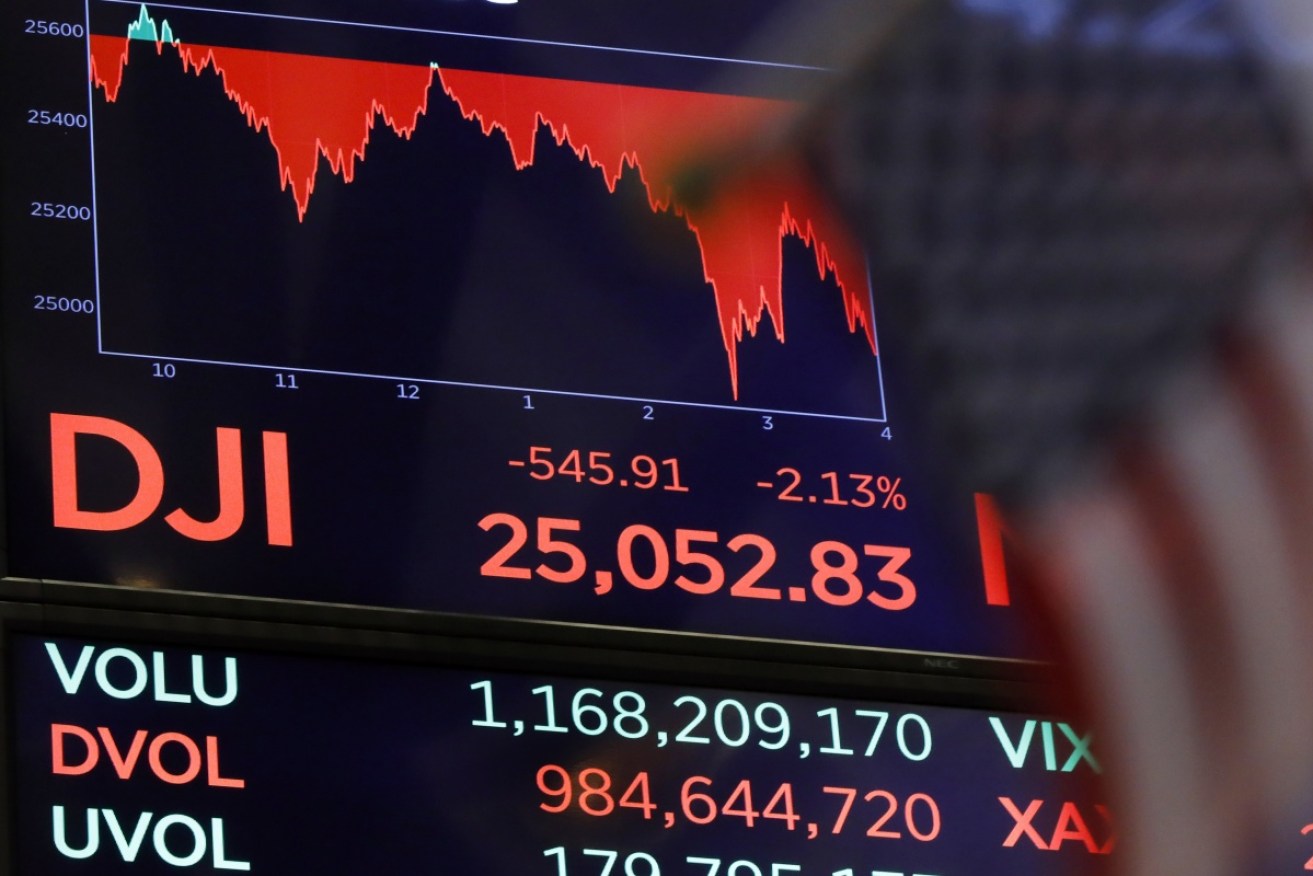Dow Jones drops 546 points as Wall Street and global market sell-off persists

At its worst, the Dow Jones index dropped by as much as 699 points. Photo: AAP
The global market sell-off continued overnight, with Wall Street falling sharply amid a volatile trading session.
At one point in the New York morning, the major US share indices were slightly higher, before capitulating and then recovering slightly in late trade.
“We saw a rally this morning, and that ended up being a suckers’ rally,” Dennis Dick, a proprietary trader at Bright Trading in Las Vegas told Reuters.
“Then you had buy-the-dippers coming in here saying this was too much, too fast.
“Are we out of the woods here? I don’t think so, you’re going to see a lot of volatility in the next week or so.”
Investors are retreating from risky investments like shares, over concerns about rising interest rates and the impact of trade wars on corporate earnings.
At its worst, the Dow Jones index dropped by as much as 699 points, before closing 546 points (2.1 per cent) lower at 25,053.
It was less severe than Wednesday, when the Dow tumbled by 832 points — its worst day in eight months.
In total, America’s industrial index plummeted by 1378 points over two days.
The benchmark index, the S&P 500, experienced its sixth straight day of losses, falling 2.1 per cent to 2,728.
Meanwhile, the technology-heavy Nasdaq index dropped by 1.3 per cent to 7329. At one point it dipped into “correction” territory, having fallen 10.3 per cent from its closing peak on August 29, but it ended 9.6 per cent down from that point.
European markets suffered even steeper losses, with London and Paris falling by 1.9 per cent each.
But Asian bourses were hit hardest on Thursday afternoon — Hong Kong (-3.5pc), Tokyo (-3.9pc), Seoul (-4.4pc) and Shanghai (-5.2pc).
China growth worries and Fed rate rises dominate
Simon Derrick, the chief currency strategist at the Bank of New York Mellon, believes the US-China trade wars and Chinese moves to stimulate their domestic economy and lower the yuan in response have been a key catalyst for the falls.
“Looking at the news headlines heading into the US open [on Wednesday] the main events had been warnings overnight from Treasury Secretary Mnuchin about CNY [yuan] devaluation and from the IMF about Chinese growth,” he wrote.
“The previous 24 hours had also seen President Trump repeat his threat to place tariffs on an additional $US267 of Chinese imports.
“In other words, the most likely cause for the sharp change of mood at the US open [on Wednesday] was concerns about Chinese growth rather than anything else.”
US markets were not soothed by comments from Mr Trump that appeared to put pressure on the US Federal Reserve to stop raising interest rates.
“I think it’s far too fast, far too rigid,” Mr Trump remarked, adding that the rate rises were, “not necessary in my opinion, and I think I know about it better than they do.”
“The Fed is out of control … I think what they’re doing is wrong.”
Mr Trump’s remarks were swiftly qualified by his top economic advisor Larry Kudlow, who said the Fed was “on target”.
The rise in interest rates is “a sign of economic health, that is something to be welcome and not feared,” Mr Kudlow told CNBC.
“The President is not dictating policy to the Fed … They are independent. They are going to do what they are going to do.”
The head of the International Monetary Fund also rushed to the Fed’s defence.
“I wouldn’t associate [Fed chair] Jay Powell with craziness,” Christine Lagarde said at an IMF meeting in Bali, Indonesia.
“No, he comes across — and members of his board — as extremely serious, solid and certainly keen to base their decisions on actual information and a desire to communicate that properly.”
Australian sell-off to persist
ASX futures are down 47 points (-0.8pc), which means the Australian share market will drift deeper into the red this morning.
While stocks fell, the price of gold jumped by 2.5pc to $US1,222 an ounce as investors rushed to safe-haven assets.
The Australian dollar has lifted to 71.2 US cents, 53.8 British pence, 61.4 Euro cents and 79.8 Japanese yen.








